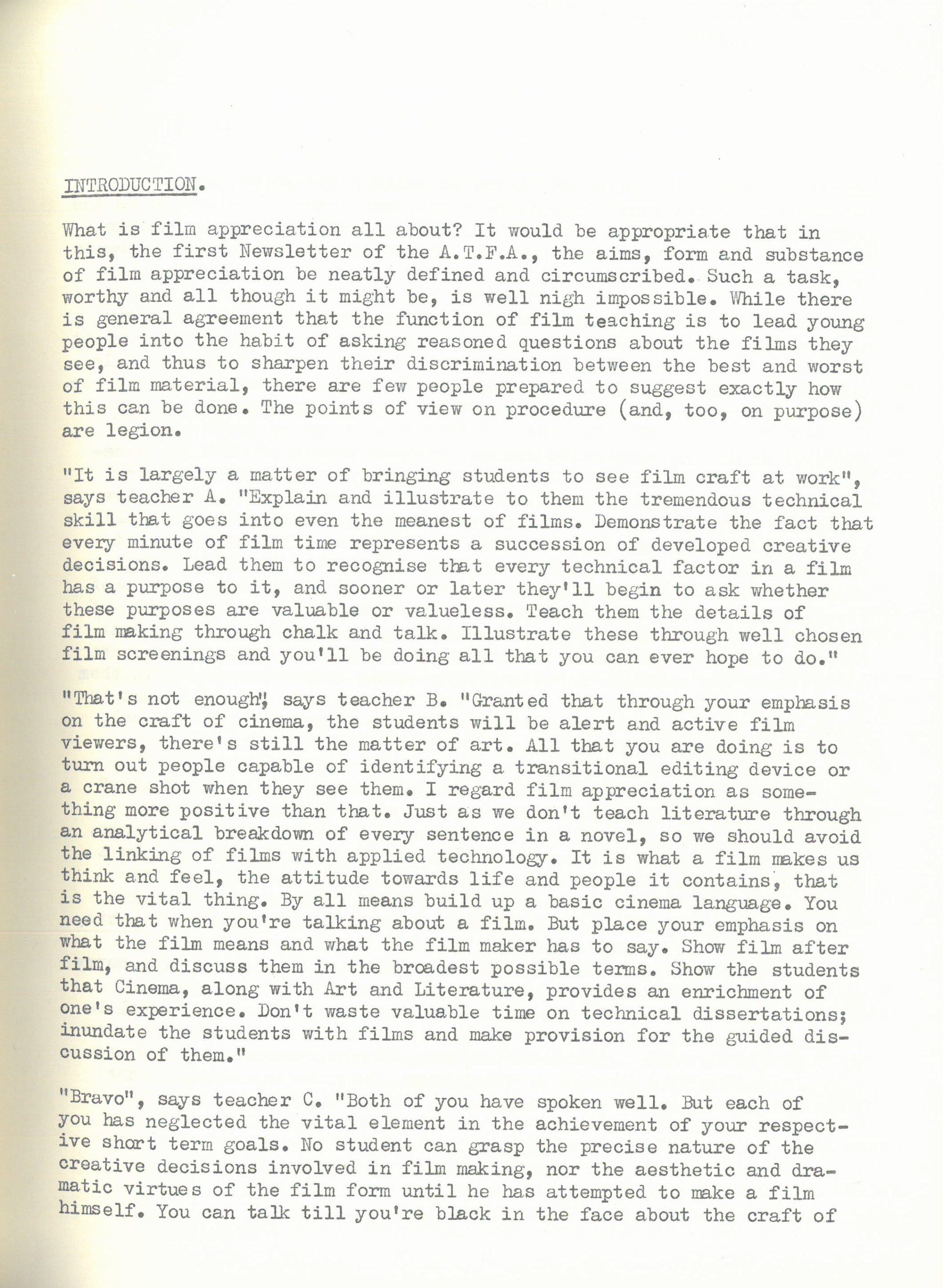What is film appreciation all about? It would be appropriate that in this, the first Newsletter of the A.T.F.A., the aims, form and substance of film appreciation be neatly defined and circumscribed. Such a task, worthy and all though it might be, is well nigh impossible. While there is general agreement that the function of film teaching is to lead young people into the habit of asking reasoned questions about the films they see, and thus to sharpen their discrimination between the best and worst of film material, there are few people prepared to suggest exactly how this can be done. The points of view on procedure (and, too, on purpose) are legion.
“It is largely a matter of bringing students to see film craft at work”, says teacher A, “Explain and illustrate to them the tremendous technical skill that goes into even the meanest of films. Demonstrate the fact that every minute of film time represents a succession of developed creative decisions. Lead them to recognise that every technical factor in a film has a purpose to it, and sooner or later they’ll begin to ask whether these purposes are valuable or valueless. Teach them the details of film making through chalk and talk. Illustrate these through well chosen film screenings and you’ll be doing all that you can ever hope to do.”
“That’s not enough”, says teacher B. “Granted that through your emphasis on the craft of cinema, the students will be alert and active film viewers, there’s still the matter of art. All that you are doing is to turn out people capable of identifying a transitional editing device or a crane shot when they see them. I regard film appreciation as something more positive than that. Just as we don’t teach literature through an analytical breakdown of every sentence in a novel, so we should avoid the linking of films with applied technology. It is what a film makes us think and feel, the attitude towards life and people it contains, that is the vital thing. By all means build up a basic cinema language. You need that when you’re talking about a film. But place your emphasis on what the film means and what the film maker has to say. Show film after film, and discuss them in the broadest possible terms. Show the students that Cinema, along with Art and Literature, provides an enrichment of one’s experience. Don’t waste valuable time on technical dissertations; inundate the students with films and make provision for the guided discussion of them.”
“Bravo”, says teacher C. “Both of you have spoken well. But each of you has neglected the vital element in the achievement of your respective short term goals. No student can grasp the precise nature of the creative decisions involved in film making, nor the aesthetic and dramatic virtues of the film form until he has attempted to make a film himself. You can talk till you’re black in the face about the craft of cinema, or about the power of cinema to relay a viewpoint, but you won’t get anywhere until your students have the same frame of reference as the professional film maker. And they can only get that by trying to make films themselves. Cast aside your chalkboard and projector. Get ye hence to the cameras!!”
Here there are three opinions on what film appreciation work should contain. The eclectic would attempt to encompass the whole three, but it is a sorry fact of existence that in this State, unlike Tasmania, film teaching is done only as a tiny segment of the general academic work, or as an extra curricular activity. Our time is all too short.
Argument about the respective merits of these points of view is valueless. Each has its virtues, and each depends upon the particular individual or professional resources open to the teacher. It can however be agreed that, no matter what the procedures used might be, the goals remain pretty much the same. We want our students first and foremost to regard the film as a valuable and serious form of communication, capable of enriching the mind and heart. We want them to be capable of discriminating between the specious or dishonest film, and the film of integrity. We want them to have some working knowledge of the special sorts of creative decisions the intelligent film maker has to make. We do not want our students to become film snobs, but rather to equip them to appreciate the particular merits that any honestly made film has to offer – be it a lightweight comedy, a detective drama, a gay musical, or a significant social analysis.
What then is the role of this Newsletter in attaining the above aims? It will supply, to those teachers somewhat rusty on film technique, material designed not only to fill in the gaps in their own knowledge, but also give suggestions on how this material could be conveyed to a group of students. It will carry articles directly relating to the teaching of film – outlines of procedure for the discussing of films, courses of study found to be useful by other teachers, sample projects, and so on. It will carry recommendations as to films and books of value in stimulating a knowledge and awareness of cinema. It will carry any material, technical or otherwise, thought to be of interest or value to anyone concerned with film as an art form. In all, it will be a means of communicating to all people involved in the thorny business of film appreciation basic material, suggestions, procedures, reviews and recommendations germane to their work. That, at any rate, is the Publications Manager’s pious hope.
[from Film Appreciation Newsletter vol. 1, no. 1]


